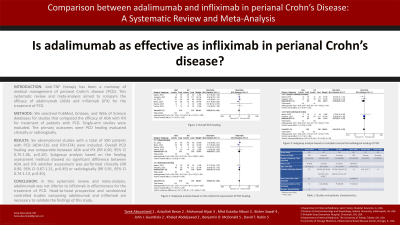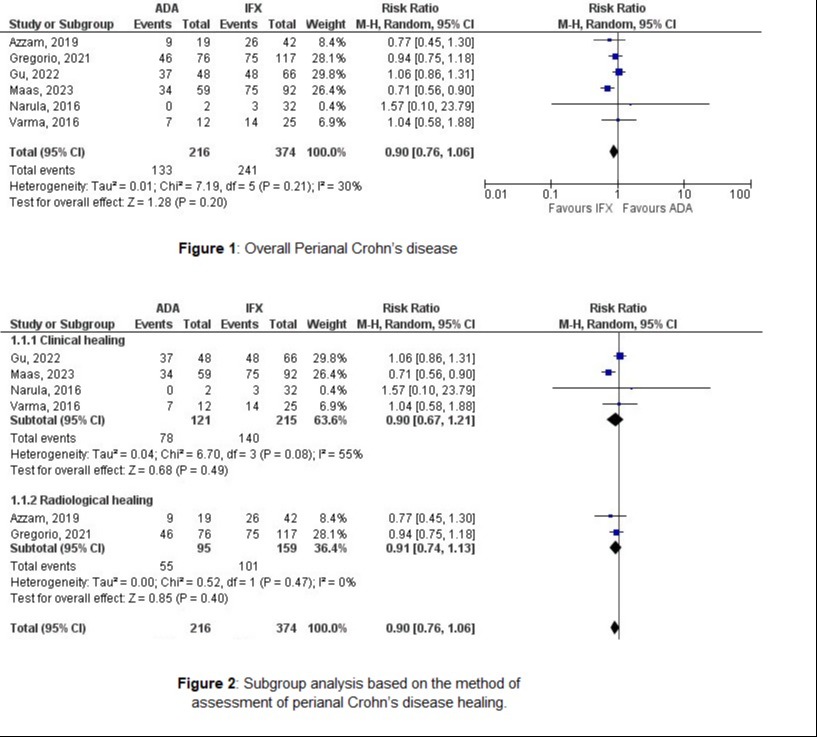Monday Poster Session
Category: IBD
P2594 - Head-to-Head Comparison Between Adalimumab and Infliximab in Perianal Crohn’s Disease: A Systematic Review and Meta-Analysis
Monday, October 28, 2024
10:30 AM - 4:00 PM ET
Location: Exhibit Hall E

Has Audio
- TA
Tarek Aboursheid, MD
Ascension Saint Francis Hospital
Evanston, IL
Presenting Author(s)
Tarek Aboursheid, MD1, Azizullah Beran, MD2, Mohamad Hijazi, MD3, Mhd K. Albuni, MD4, Bisher Sawaf, MD5, Khaled Abdeljawad, MD6, M Kenan Rahima, MD7
1Ascension Saint Francis Hospital, Evanston, IL; 2Indiana University School of Medicine, Indianapolis, IN; 3TriHealth Corporation, Cincinnati, OH; 4TriHealth, Cincinnati, OH; 5University of Toledo Health Sciences Campus, Toledo, OH; 6Indiana University, Indianapolis, IN; 7TriHealth Good Samaritan Hospital, Cincinnati, OH
Introduction: Perianal Fistulizing Crohn's disease (PF-CD) can have a significant deleterious impact on the quality of life, and its management presents notable clinical challenges. Anti-TNF has been the mainstay of medical management of PF-CD, especially with infliximab (IFX), but other Anti-TNF medications are commonly used such as Adalimumab (ADA). Published studies primarily evaluate individual treatments rather than direct comparisons between them. In order to directly compare the efficacy of IFX and ADA to treat PF-CD, we conducted a met-analysis and a systematic review of the current literature
Methods: We searched PubMed, Embase, and Web of Science databases for studies that compared the efficacy of ADA with IFX for treatment of PF-CD. Single-arm studies were excluded. Pooled risk ratios (RR) with corresponding 95% confidence intervals (CIs) were calculated by the Mantel-Haenszel method within a random-effect model. The primary outcome was overall PF-CD healing, which was defined as healing by clinical or radiological assessment. Subgroup analysis was performed based on PF-CD healing assessment method (clinical vs. radiological) and the degree of radiological healing (partial vs. complete radiological healing).
Results: Six observational studies with a total of 590 patients with perianal CD (ADA =216, IFX= 374) were included. The duration of treatment ranged between 1 year and 3.8 years. Combined immunomodulator use was reported in 3 studies without significant difference between the two groups. Four studies evaluated fistula healing clinically and two studies used MRI. Overall PF-CD healing was comparable between ADA and IFX (RR 0.90, 95% CI 0.76-1.06, p=0.20). Subgroup analysis based on the healing assessment method showed no significant difference between ADA and IFX whether assessment was performed clinically (RR 0.90, 95% CI 0.67-1.21, p=0.49) or radiologically (RR 0.91, 95% CI 0.74-1.13, p=0.40).
Discussion: Our study is the first meta-analysis to directly compare the efficacy of ADA and IFX in PF-CD. We found that ADA was non-inferior to IFX in treating PF-CD. Considering the superior accuracy of radiological assessment of healing, we performed a subgroup analysis focusing on the healing assessment method. ADA remained non-inferior to IFX whether the assessment of healing was done clinically or radiologically.
Our findings suggest that ADA may be an acceptable alternative to IFX for PF-CD. Large-scale head-to-head randomized controlled trials are necessary to validate our results.

Disclosures:
Tarek Aboursheid, MD1, Azizullah Beran, MD2, Mohamad Hijazi, MD3, Mhd K. Albuni, MD4, Bisher Sawaf, MD5, Khaled Abdeljawad, MD6, M Kenan Rahima, MD7. P2594 - Head-to-Head Comparison Between Adalimumab and Infliximab in Perianal Crohn’s Disease: A Systematic Review and Meta-Analysis, ACG 2024 Annual Scientific Meeting Abstracts. Philadelphia, PA: American College of Gastroenterology.
1Ascension Saint Francis Hospital, Evanston, IL; 2Indiana University School of Medicine, Indianapolis, IN; 3TriHealth Corporation, Cincinnati, OH; 4TriHealth, Cincinnati, OH; 5University of Toledo Health Sciences Campus, Toledo, OH; 6Indiana University, Indianapolis, IN; 7TriHealth Good Samaritan Hospital, Cincinnati, OH
Introduction: Perianal Fistulizing Crohn's disease (PF-CD) can have a significant deleterious impact on the quality of life, and its management presents notable clinical challenges. Anti-TNF has been the mainstay of medical management of PF-CD, especially with infliximab (IFX), but other Anti-TNF medications are commonly used such as Adalimumab (ADA). Published studies primarily evaluate individual treatments rather than direct comparisons between them. In order to directly compare the efficacy of IFX and ADA to treat PF-CD, we conducted a met-analysis and a systematic review of the current literature
Methods: We searched PubMed, Embase, and Web of Science databases for studies that compared the efficacy of ADA with IFX for treatment of PF-CD. Single-arm studies were excluded. Pooled risk ratios (RR) with corresponding 95% confidence intervals (CIs) were calculated by the Mantel-Haenszel method within a random-effect model. The primary outcome was overall PF-CD healing, which was defined as healing by clinical or radiological assessment. Subgroup analysis was performed based on PF-CD healing assessment method (clinical vs. radiological) and the degree of radiological healing (partial vs. complete radiological healing).
Results: Six observational studies with a total of 590 patients with perianal CD (ADA =216, IFX= 374) were included. The duration of treatment ranged between 1 year and 3.8 years. Combined immunomodulator use was reported in 3 studies without significant difference between the two groups. Four studies evaluated fistula healing clinically and two studies used MRI. Overall PF-CD healing was comparable between ADA and IFX (RR 0.90, 95% CI 0.76-1.06, p=0.20). Subgroup analysis based on the healing assessment method showed no significant difference between ADA and IFX whether assessment was performed clinically (RR 0.90, 95% CI 0.67-1.21, p=0.49) or radiologically (RR 0.91, 95% CI 0.74-1.13, p=0.40).
Discussion: Our study is the first meta-analysis to directly compare the efficacy of ADA and IFX in PF-CD. We found that ADA was non-inferior to IFX in treating PF-CD. Considering the superior accuracy of radiological assessment of healing, we performed a subgroup analysis focusing on the healing assessment method. ADA remained non-inferior to IFX whether the assessment of healing was done clinically or radiologically.
Our findings suggest that ADA may be an acceptable alternative to IFX for PF-CD. Large-scale head-to-head randomized controlled trials are necessary to validate our results.

Figure: Figure 1: Overall Perianal Crohn’s disease healing.
Figure 2: Subgroup analysis based on the method of assessment of perianal Crohn’s disease healing.
Figure 2: Subgroup analysis based on the method of assessment of perianal Crohn’s disease healing.
Disclosures:
Tarek Aboursheid indicated no relevant financial relationships.
Azizullah Beran indicated no relevant financial relationships.
Mohamad Hijazi indicated no relevant financial relationships.
Mhd Albuni indicated no relevant financial relationships.
Bisher Sawaf indicated no relevant financial relationships.
Khaled Abdeljawad indicated no relevant financial relationships.
M Kenan Rahima indicated no relevant financial relationships.
Tarek Aboursheid, MD1, Azizullah Beran, MD2, Mohamad Hijazi, MD3, Mhd K. Albuni, MD4, Bisher Sawaf, MD5, Khaled Abdeljawad, MD6, M Kenan Rahima, MD7. P2594 - Head-to-Head Comparison Between Adalimumab and Infliximab in Perianal Crohn’s Disease: A Systematic Review and Meta-Analysis, ACG 2024 Annual Scientific Meeting Abstracts. Philadelphia, PA: American College of Gastroenterology.
